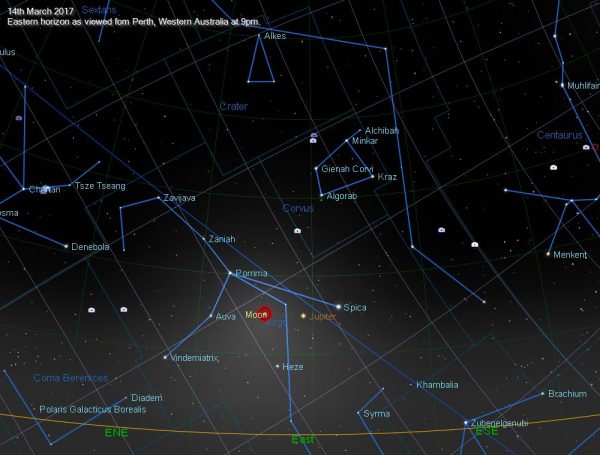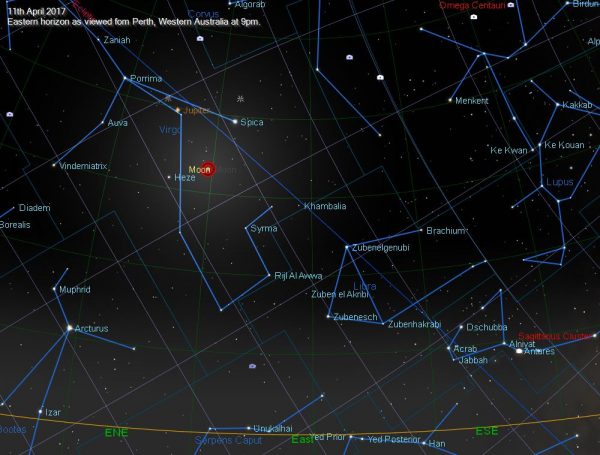Conjunction of Jupiter, the Moon and Spica provide great for viewing and photography
For the last few months, Jupiter has been quietly gliding through the constellation of Virgo. I say quietly because not many people will have noticed this late nice wander of the planet, as Jupiter has been rising rather late (after 10pm). Now that Jupiter is rising earlier in the evening there are some nice viewing and photographic opportunities on the eastern horizon.
Jupiter is gliding past the bright star Spica in the constellation of Virgo. Once or twice each month the Moon joins the party, appearing reasonably close to the duo in what astronomers call a Conjunction. These conjunctions provide for a nice scene in our eastern night sky. Here’s a summary:
March 14th & 15th
On the 14th and 15th The Moon, Jupiter and Spica are in close proximity to each other. On the 14th the Moon will be almost in line horizontally with Jupiter and Spica, on the 15th it will be below the duo. The Moon will be a couple of days past full, so the terminator will be encroaching on the otherwise full disk of the moon. The best time for viewing will be after 9 pm.

April 11th
On the 11th April the Moon, Jupiter and Spica will make a nice equilateral triangle. Higher in the sky earlier than the March conjunction this will be more favourable for sharp photographs of the trio, but more difficult to include foreground elements if attempting a nightscape type photograph. The Moon will be very full – 99.79% illuminated.

Viewing & Photography Tips
The first thing to remember with such events is that while the dates mentioned are the optimum for these particular conjunctions the days either side are not bad also, with a varying spacing of the celestial objects. So, if it’s cloudy on one night, try another adjacent night.
Visually you need nothing more than your eyeballs and a relatively clear eastern horizon to see the conjunctions. If you have binoculars, ideally a large aperture pair such as an 8x40mm or 10x50mm you will be able to see not only the conjunction but nice surface detail on the Moon and also some brighter moons of Jupiter. Exactly which moons of Jupiter you see will depend on when you are out there – it is surprising how quickly their arrangement changes!
Photographically conjunctions are one of the easiest types of astrophotography. Being bright objects you can keep the exposure times short so all you need is a sturdy tripod and a camera that has exposure controls. Ideally, you would use a 2 or 10-second delay, or a cable release, to minimise vibrations at the camera, and you would manually focus by using Live View (or similar) on Jupiter or Spica to get sharp focus. Try different aperture and ISO configurations, but you should not need an ISO higher than 800 or a shutter speed longer than 5 seconds.
If you would like a closer view of Jupiter and the Moon book into a Night Sky Tour during April or May and we’ll be more than happy to show you the objects through one of our telescopes.





